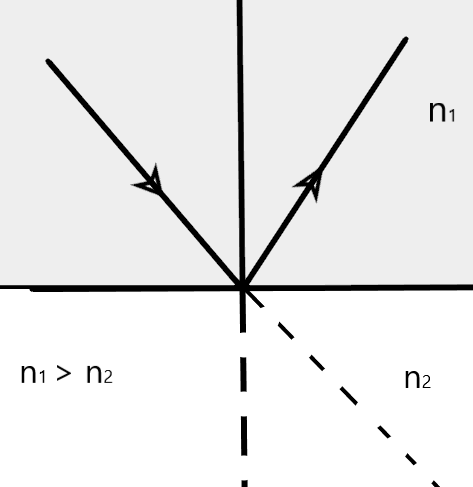
Assertion: The images formed by total internal reflection are much brighter than those formed by mirrors or lenses.
Reason: There is no loss of intensity in total internal reflections.
A) Both assertion and the reason are correct and the reason is the correct explanation for the assertion.
B) Both assertion and reason are correct, but the reason is not the correct explanation.
C) Assertion is correct, but the reason is wrong
D) Both assertion and reason are wrong.
Answer
557.4k+ views
Hint: We need to understand the concept of image formation by the total internal reflection and the image formation by the mirrors and lenses to compare the brightness of the images formed in both situations under the same conditions of the object.
Complete step by step solution:
The image formation in total internal reflection and a mirror or lens has to be discussed parallelly to understand the difference between the images formed by them.
In mirrors or lenses, the image formed is by the reflection or the refraction of the light rays falling on them. In a mirror, the amount of light incident and the light reflected back are never the same. The ratio between the reflected ray and the incident ray will be always lesser than one. This is because, in a mirror, the shining surface, how strongly reflecting they are, the light rays can refract and get transmitted to the medium which results in the lowering of the intensity of the reflected light. This, as a result, lowers the brightness.
In the total internal reflection, the light rays traveling from a denser medium to a rarer medium get reflected at some point when the angle of incidence is greater than the critical angle. In such a case, the light rays cannot refract through the medium and the total reflection of the incident light rays take place. The ratio between the reflected ray intensity and the incident ray intensity will be one always.

Due to this reason, the light from total internal reflection appears to be brighter than the normal reflection.
Therefore, the correct answer is option (A).
Note: Even though we say that the total internal reflection is brighter than the normal reflection, it doesn’t mean that the light rays are very much brighter than the normally reflected rays. The rays will always be having a light intensity equal to or lesser than that of the incident ray.
Complete step by step solution:
The image formation in total internal reflection and a mirror or lens has to be discussed parallelly to understand the difference between the images formed by them.
In mirrors or lenses, the image formed is by the reflection or the refraction of the light rays falling on them. In a mirror, the amount of light incident and the light reflected back are never the same. The ratio between the reflected ray and the incident ray will be always lesser than one. This is because, in a mirror, the shining surface, how strongly reflecting they are, the light rays can refract and get transmitted to the medium which results in the lowering of the intensity of the reflected light. This, as a result, lowers the brightness.
In the total internal reflection, the light rays traveling from a denser medium to a rarer medium get reflected at some point when the angle of incidence is greater than the critical angle. In such a case, the light rays cannot refract through the medium and the total reflection of the incident light rays take place. The ratio between the reflected ray intensity and the incident ray intensity will be one always.

Due to this reason, the light from total internal reflection appears to be brighter than the normal reflection.
Therefore, the correct answer is option (A).
Note: Even though we say that the total internal reflection is brighter than the normal reflection, it doesn’t mean that the light rays are very much brighter than the normally reflected rays. The rays will always be having a light intensity equal to or lesser than that of the incident ray.
Recently Updated Pages
A man running at a speed 5 ms is viewed in the side class 12 physics CBSE

The number of solutions in x in 02pi for which sqrt class 12 maths CBSE

State and explain Hardy Weinbergs Principle class 12 biology CBSE

Write any two methods of preparation of phenol Give class 12 chemistry CBSE

Which of the following statements is wrong a Amnion class 12 biology CBSE

Differentiate between action potential and resting class 12 biology CBSE

Trending doubts
What are the major means of transport Explain each class 12 social science CBSE

Which are the Top 10 Largest Countries of the World?

Draw a labelled sketch of the human eye class 12 physics CBSE

How much time does it take to bleed after eating p class 12 biology CBSE

Explain sex determination in humans with line diag class 12 biology CBSE

When was the first election held in India a 194748 class 12 sst CBSE




